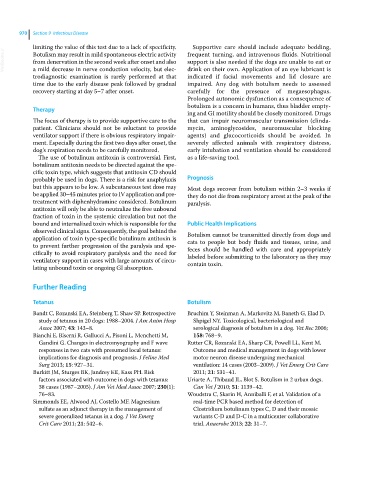Page 1032 - Clinical Small Animal Internal Medicine
P. 1032
970 Section 9 Infectious Disease
limiting the value of this test due to a lack of specificity. Supportive care should include adequate bedding,
VetBooks.ir Botulism may result in mild spontaneous electric activity frequent turning, and intravenous fluids. Nutritional
support is also needed if the dogs are unable to eat or
from denervation in the second week after onset and also
a mild decrease in nerve conduction velocity, but elec-
indicated if facial movements and lid closure are
trodiagnostic examination is rarely performed at that drink on their own. Application of an eye lubricant is
time due to the early disease peak followed by gradual impaired. Any dog with botulism needs to assessed
recovery starting at day 5–7 after onset. carefully for the presence of megaesophagus.
Prolonged autonomic dysfunction as a consequence of
botulism is a concern in humans, thus bladder empty-
Therapy
ing and GI motility should be closely monitored. Drugs
The focus of therapy is to provide supportive care to the that can impair neuromuscular transmission (clinda-
patient. Clinicians should not be reluctant to provide mycin, aminoglycosides, neuromuscular blocking
ventilator support if there is obvious respiratory impair- agents) and glucocorticoids should be avoided. In
ment. Especially during the first two days after onset, the severely affected animals with respiratory distress,
dog’s respiration needs to be carefully monitored. early intubation and ventilation should be considered
The use of botulinum antitoxin is controversial. First, as a life‐saving tool.
botulinum antitoxin needs to be directed against the spe-
cific toxin type, which suggests that antitoxin CD should
probably be used in dogs. There is a risk for anaphylaxis Prognosis
but this appears to be low. A subcutaneous test dose may Most dogs recover from botulism within 2–3 weeks if
be applied 30–45 minutes prior to IV application and pre- they do not die from respiratory arrest at the peak of the
treatment with diphenhydramine considered. Botulinum paralysis.
antitoxin will only be able to neutralize the free unbound
fraction of toxin in the systemic circulation but not the
bound and internalized toxin which is responsible for the Public Health Implications
observed clinical signs. Consequently, the goal behind the Botulism cannot be transmitted directly from dogs and
application of toxin type‐specific botulinum antitoxin is cats to people but body fluids and tissues, urine, and
to prevent further progression of the paralysis and spe- feces should be handled with care and appropriately
cifically to avoid respiratory paralysis and the need for labeled before submitting to the laboratory as they may
ventilatory support in cases with large amounts of circu- contain toxin.
lating unbound toxin or ongoing GI absorption.
Further Reading
Tetanus Botulism
Bandt C, Rozanski EA, Steinberg T, Shaw SP. Retrospective Bruchim Y, Steinman A, Markovitz M, Baneth G, Elad D,
study of tetanus in 20 dogs: 1988–2004. J Am Anim Hosp Shpigel NY. Toxicological, bacteriological and
Assoc 2007; 43: 143–8. serological diagnosis of botulism in a dog. Vet Rec 2006;
Bianchi E, Biserni R, Gallucci A, Pisoni L, Menchetti M, 158: 768–9.
Gandini G. Changes in electromyography and F wave Rutter CR, Rozanski EA, Sharp CR, Powell LL, Kent M.
responses in two cats with presumed local tetanus: Outcome and medical management in dogs with lower
implications for diagnosis and prognosis. J Feline Med motor neuron disease undergoing mechanical
Surg 2013; 15: 927–31. ventilation: 14 cases (2003–2009). J Vet Emerg Crit Care
Burkitt JM, Sturges BK, Jandrey KE, Kass PH. Risk 2011; 21: 531–41.
factors associated with outcome in dogs with tetanus: Uriarte A, Thibaud JL, Blot S. Botulism in 2 urban dogs.
38 cases (1987–2005). J Am Vet Med Assoc 2007; 230(1): Can Vet J 2010; 51: 1139–42.
76–83. Woudstra C, Skarin H, Anniballi F, et al. Validation of a
Simmonds EE, Alwood AJ, Costello MF. Magnesium real‐time PCR based method for detection of
sulfate as an adjunct therapy in the management of Clostridium botulinum types C, D and their mosaic
severe generalized tetanus in a dog. J Vet Emerg variants C‐D and D‐C in a multicenter collaborative
Crit Care 2011; 21: 542–6. trial. Anaerobe 2013; 22: 31–7.

